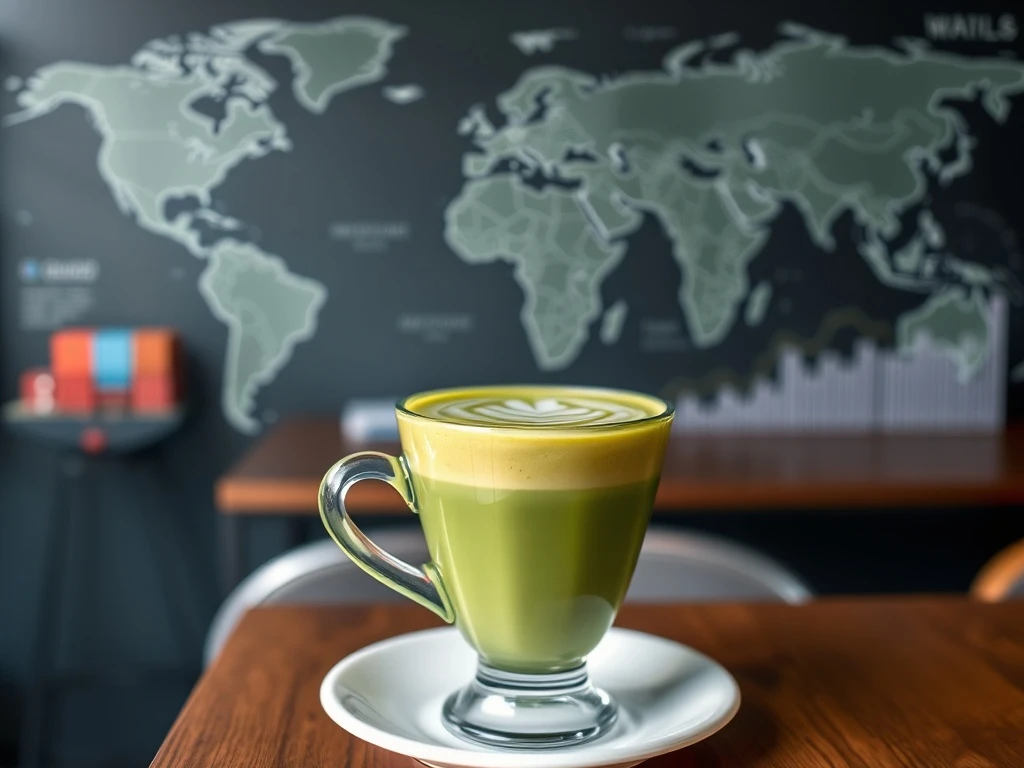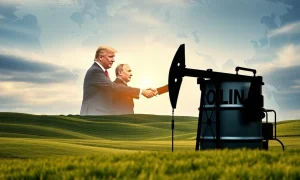The price of your daily matcha latte has likely increased. This seemingly small change reveals a much larger story. It points to significant Global Trade Issues impacting economies worldwide. Understanding these broader economic shifts is crucial for any business or entrepreneur. This article explains how a simple beverage illustrates complex global challenges. It connects everyday consumer costs to the intricate web of international commerce. Furthermore, it highlights the forces currently reshaping the global economic landscape.
The Matcha Latte: A Microcosm of Global Trade Issues
Consider the journey of your matcha latte. It begins on a tea farm, often in Japan or China. Farmers carefully cultivate the tea leaves. They then process these leaves into a fine powder. Subsequently, the matcha powder undergoes packaging. It travels thousands of miles across oceans to reach your local café. This entire process involves a complex global supply chain. Many different actors play a role. They include farmers, processors, logistics companies, and retailers. Disruptions at any stage create ripple effects. Ultimately, these issues contribute to rising costs for consumers. This journey perfectly illustrates prevalent Global Trade Issues.
Every ingredient in your latte has a similar journey. Milk comes from dairy farms. Sweeteners are sourced from various regions. Cups and lids originate from manufacturing plants. Each component travels through its own supply network. Therefore, a price increase for one ingredient impacts the final product. The global nature of sourcing makes the entire system vulnerable. It is susceptible to a range of external pressures. These pressures directly influence the cost of your beverage. Thus, your matcha latte serves as a tangible example of these challenges.
Unpacking Supply Chain Disruptions and Rising Costs
Recent years saw unprecedented supply chain disruptions. The COVID-19 pandemic, for instance, closed factories and ports worldwide. This caused immediate bottlenecks. Shipping container shortages became severe. This pushed freight costs to record highs. For example, the cost to ship a container from Asia to North America surged tenfold. Furthermore, the Suez Canal blockage in 2021 further complicated matters. It halted global shipping for days. These events directly contributed to the current Global Trade Issues.
Businesses faced immense pressure. They experienced significant delays. Their operational expenses increased dramatically. Consequently, these higher costs passed down to consumers. Raw material prices also climbed. This reflected increased demand and reduced supply. Labor shortages across various sectors exacerbated the problem. Port workers, truck drivers, and factory employees were scarce. This reduced efficiency in logistics and manufacturing. Therefore, these combined factors significantly impacted global trade. They made everyday goods more expensive for everyone.
Key disruptions included:
- Pandemic-related shutdowns: Factories closed, limiting production.
- Logistical bottlenecks: Port congestion and container shortages delayed shipments.
- Labor scarcity: Shortages of workers impacted transport and manufacturing.
- Increased freight costs: Shipping rates soared due to demand and limited capacity.
These challenges collectively demonstrate the fragility of modern supply chains. They highlight the need for greater resilience. Addressing these vulnerabilities is crucial for future stability. Many companies are now rethinking their entire operational models. They aim to build more robust systems. This helps mitigate the impact of future disruptions. It is a direct response to ongoing Global Trade Issues.
Geopolitical Tensions Reshaping Global Trade Issues
Geopolitical tensions significantly influence global trade. Trade wars between major economies, like the US and China, introduced tariffs. These taxes on imported goods raise prices. They make certain products less competitive. Sanctions on specific countries further restrict resource flows. For instance, sanctions can limit access to vital raw materials. This forces companies to seek alternative, often more expensive, suppliers. These actions directly impact international commerce. They contribute substantially to current Global Trade Issues.
Political instability in key regions also poses risks. Conflicts can disrupt shipping routes. They may also affect energy supplies. This creates uncertainty for businesses. Companies must then adapt their sourcing and distribution strategies. They might prioritize political stability over cost efficiency. This shift can lead to higher operational expenses. Furthermore, it can reduce market access for some goods. The push for economic decoupling also gains traction. Nations seek to reduce reliance on adversaries. This further fragments global supply chains. It also creates new barriers to trade.
For example, the increasing focus on national security has prompted some countries to reshore critical industries. This means bringing production back home. While it enhances domestic resilience, it often increases costs. Such policies reflect a growing trend towards protectionism. They can undermine the principles of free trade. Consequently, these geopolitical dynamics add layers of complexity. They make global trade more unpredictable. Navigating these tensions is a primary concern for businesses worldwide. They represent a significant part of the ongoing Global Trade Issues.
Inflationary Pressures and Consumer Price Hikes
Global inflationary pressures represent another major factor. Energy prices have soared recently. This directly impacts transportation and manufacturing costs. For example, the cost of fuel for container ships and trucks has risen sharply. Businesses then pass these higher operational costs to consumers. Labor shortages in many sectors persist. This drives up wages. Companies must pay more to attract and retain employees. These increased labor costs also contribute to inflation. Your matcha latte ingredients, from tea to milk, become more expensive. This general inflation compounds existing Global Trade Issues.
Demand-supply imbalances also play a role. During the pandemic, consumer demand for goods surged. However, production and shipping capacities struggled to keep pace. This imbalance pushed prices higher. Furthermore, governments injected significant stimulus into economies. This increased the money supply. It also fueled consumer spending. While intended to support economies, it contributed to inflationary pressures. Central banks are now raising interest rates to combat inflation. This makes borrowing more expensive for businesses and consumers. Such measures can slow economic growth. They also add another layer of complexity to the global trade environment.
The cumulative effect of these pressures is visible in everyday prices. Everything from groceries to electronics costs more. This erodes consumer purchasing power. Businesses face tough decisions regarding pricing and profitability. They must balance rising input costs with consumer affordability. Therefore, managing inflation is a critical challenge for policymakers globally. It directly impacts the stability of international commerce. It further exacerbates the complex nature of Global Trade Issues.
The Evolving Landscape of International Commerce
Companies now prioritize resilience over pure cost efficiency. Many are considering strategies like nearshoring or friendshoring. Nearshoring involves moving production closer to home markets. Friendshoring means relocating production to politically allied nations. This reduces geopolitical risks. It also shortens supply lines. While potentially more expensive, these strategies aim for greater stability. Diversifying supply chains also gains traction. Businesses are spreading their production across multiple countries. This reduces reliance on a single region or supplier. It helps mitigate the impact of localized disruptions. These shifts are a direct response to recent Global Trade Issues.
Technological advancements offer new solutions. Artificial intelligence (AI) can predict supply chain disruptions. It optimizes logistics routes. Blockchain technology provides transparency and traceability. This helps verify the origin of goods. It also ensures ethical sourcing. Automation in ports and warehouses improves efficiency. These technologies make supply chains smarter and more adaptable. They allow businesses to react more quickly to unforeseen events. Furthermore, data analytics provides valuable insights. Companies use this data to make informed decisions. This improves risk management strategies.
The global trade landscape is undergoing a fundamental transformation. The era of hyper-globalization might be giving way to a more regionalized approach. Trade blocs could become more prominent. Bilateral agreements may gain importance over multilateral ones. Businesses must adapt to this changing environment. They need agile strategies. They also require robust risk management frameworks. This proactive approach is essential for navigating future challenges. It is vital for addressing the evolving nature of Global Trade Issues.
Strategic Responses to Mitigate Global Trade Issues
Addressing current Global Trade Issues requires multi-faceted approaches. Governments are exploring new trade agreements. These agreements aim to diversify supply sources. They also seek to reduce dependence on single countries. Regulatory reforms are simplifying customs procedures. They are also streamlining cross-border logistics. Investments in infrastructure are crucial. This includes modernizing ports, roads, and railways. Efficient infrastructure supports smoother movement of goods. International organizations foster cooperation. They work on common standards and dispute resolution mechanisms. These efforts promote a more stable and predictable trading environment.
Businesses are also adopting more agile strategies. They are building larger inventory buffers. This provides a cushion against unexpected delays. They are also diversifying their supplier base. This reduces reliance on any single vendor. Implementing advanced risk management systems is critical. These systems identify potential disruptions early. They allow companies to respond proactively. Furthermore, digital transformation plays a key role. Companies are investing in supply chain visibility tools. These tools provide real-time data on shipments and inventory. This enables better decision-making.
Collaboration across the supply chain is also increasing. Manufacturers, logistics providers, and retailers are sharing information. This improves coordination and efficiency. Public-private partnerships are addressing infrastructure gaps. They are also developing new technologies. Such collective action is essential. It helps build a more resilient global trade system. Ultimately, a combination of policy, technology, and corporate strategy will shape the future. These combined efforts aim to mitigate the impact of future Global Trade Issues. They seek to ensure greater stability in international commerce.
The humble matcha latte offers a clear window into complex global economic forces. Its rising price reflects ongoing supply chain challenges. It also highlights geopolitical tensions and inflationary pressures. Understanding these dynamics is crucial for businesses and consumers alike. The global trade system faces unprecedented strain. However, adaptive strategies and collaborative efforts offer paths forward. Future trade stability depends on continuous innovation and international cooperation. By recognizing these interconnected issues, we can better navigate the evolving economic landscape.
Frequently Asked Questions (FAQs)
What are the primary factors contributing to current Global Trade Issues?
Several factors contribute to current Global Trade Issues. These include supply chain disruptions caused by events like the COVID-19 pandemic and geopolitical tensions such as trade wars and sanctions. Additionally, rising inflation, increased energy costs, and labor shortages significantly impact the cost and flow of goods globally.
How do supply chain disruptions affect consumer prices?
Supply chain disruptions increase consumer prices in multiple ways. They lead to higher shipping costs, delays in production, and shortages of raw materials. Businesses then pass these increased operational expenses onto consumers, resulting in higher retail prices for various goods, including everyday items like a matcha latte.
What role do geopolitical tensions play in global trade?
Geopolitical tensions introduce uncertainty and complexity into global trade. Trade wars, tariffs, and sanctions can restrict market access and force companies to find new, often more expensive, suppliers. This leads to higher production costs and can disrupt established trade routes, contributing significantly to Global Trade Issues.
What strategies are businesses adopting to mitigate Global Trade Issues?
Businesses are adopting several strategies. These include diversifying their supplier base to reduce reliance on single regions, implementing nearshoring or friendshoring to bring production closer to home or allied nations, and investing in technology like AI and blockchain for better supply chain visibility and efficiency. They also focus on building inventory buffers and robust risk management systems.
How does inflation impact the global trade system?
Inflation, driven by factors like rising energy prices and labor costs, increases the cost of producing and transporting goods globally. This reduces purchasing power for consumers and forces businesses to raise prices, making international trade more expensive and less predictable. It adds another layer of challenge to existing Global Trade Issues.
What is the future outlook for global trade given these challenges?
The future outlook for global trade suggests a shift towards more resilient and diversified supply chains. While challenges persist, there will likely be increased regionalization of trade and greater emphasis on international cooperation and technological adoption to build more robust systems. Businesses and governments will need adaptive strategies to navigate these evolving dynamics.
























